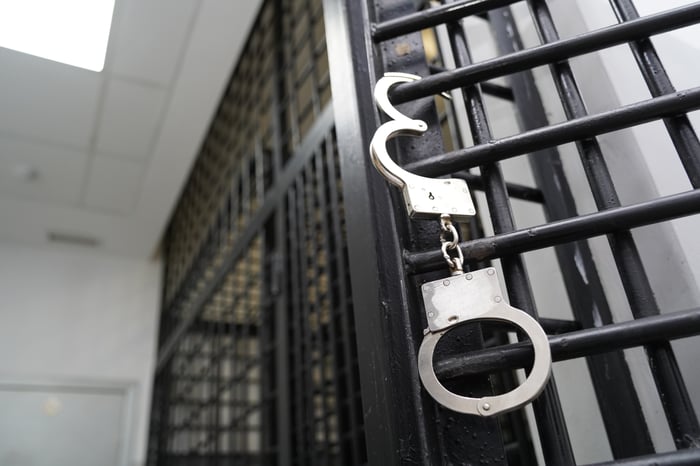Texas A&M School of Law’s Civil Rights Clinic and Immigrant Rights Clinic recently filed three federal lawsuits, featured in a Washington Post article, seeking to hold the government accountable for abuses conducted in immigration detention and removal. This abuse included unlawful and excessive use of force and restraints, punitive solitary confinement, forced fingerprinting, inappropriate use of pepper spray, and medical neglect.
The plaintiffs were all asylum seekers — six from Cameroon and one from Uganda — who fled persecution and torture in their home countries.
Two of the lawsuits involved immigration authorities’ use of a full-body restraint device called “The WRAP.” Plaintiffs were restrained in The WRAP at detention centers, during land transport, and aboard both domestic and international flights. ICE applied The WRAP in ways that violate the manufacturer’s guidance, as well as ICE’s own policies on use of force and restraints.
ICE applied The WRAP on top of five-point shackles and tightened it in a way that caused them to be bent over at a 45-degree angle, a stress position that inflicted extreme pain and suffering amounting to torture. The plaintiffs all had medical conditions that increased the risk of harm in The WRAP. ICE officers did not consider the plaintiffs’ medical conditions before applying The WRAP and then left them unattended in the restraint.
“Our students have taken a leading role in this multifaceted advocacy on behalf of their clients,” said Prof. Sara Zampierin, director of the Texas A&M Civil Rights Clinic. “Through this work, they have demonstrated their ability to tackle complex problems, faithfully recount their clients’ stories, and zealously represent these clients in seeking justice.”
One plaintiff, who has coronary artery disease, experienced chest pain in The WRAP and had to be removed from a deportation flight shortly before take-off and treated in an ambulance. Another plaintiff was known to have asthma but was given only one puff of his inhaler during his time in The WRAP, despite his cries for help. A third plaintiff, Steven Tendo, who currently lives in Vermont, was not allowed to use the restroom during many hours in The WRAP, forcing him to soil himself. He was also denied access to food, water, and his medications while in the WRAP.
Five of the plaintiffs were deported to Cameroon, where their lives were put in jeopardy because ICE did not allow them to remove sensitive asylum documents from their luggage and then handed both the individuals and their bags directly to Cameroonian authorities.
ICE’s actions violated a rule requiring immigration authorities to keep sensitive asylum-related information confidential. Cameroonian authorities searched their bags, leading to detention and further harm in some cases. As Human Rights Watch explained in its extensive report, many individuals deported on the two flights to Cameroon in October and November 2020 suffered the same fate upon arrival.
The Immigrant Rights Clinic and Civil Rights Clinic have filed over two dozen applications for humanitarian parole on behalf of Cameroonians based on violations of the confidentiality of their asylum documents.
“These cases were like immigration trench warfare,” said Prof. Fatma Marouf, director of the Texas A&M Immigrant Rights Clinic. “Students were interviewing clients who were thousands of miles away using WhatsApp to document the detention, rape, and torture they experienced after being deported.”
The Immigrant Rights Clinic also previously filed a complaint with the DHS Office for Civil Rights and Civil Liberties (CRCL) regarding ICE’s use of The WRAP, which led to a lengthy investigation by CRCL and a report making recommendations for ICE.
Texas A&M Law students shared part of their experiences working on these cases.
“Working on the FTCA complaint has been one of the most rewarding experiences of my law school journey,” said 3L Emma Blackmon. “As part of my clinic experience, I developed client relationships, brainstormed litigation strategy with lawyers across the country, and acquired practical skills that I know I will carry into my career.”
Similarly, 3L Ana Martinez described her experience working on the FTCA cases as “an eye-opening experience on the depths of daily abuses the immigrant community faces.” Martinez, who was recently awarded a highly competitive Equal Justice Works fellowship, explained that her work with the clinic solidified her commitment to working with this community in the legal world.
“The most rewarding aspect of working on this complaint wasn't just the legal intricacies, but the human stories intertwined within,” she said.
Donté Houston, a 2L, described his work on the case as a rewarding experience and emphasized the need for accountability and oversight at the highest levels of government.
“Through a united effort and effective advocacy, we can demand justice,” he said.
The Clinics’ co-counsel in the federal lawsuits include the Center for Constitutional Rights, RFK Human Rights, the Vermont Law School Center for Justice Reform Clinic, and other pro bono counsel.
